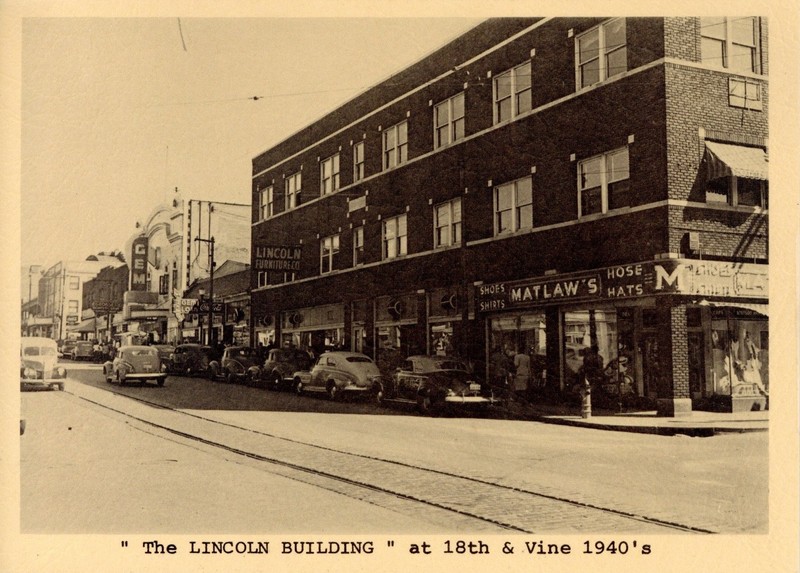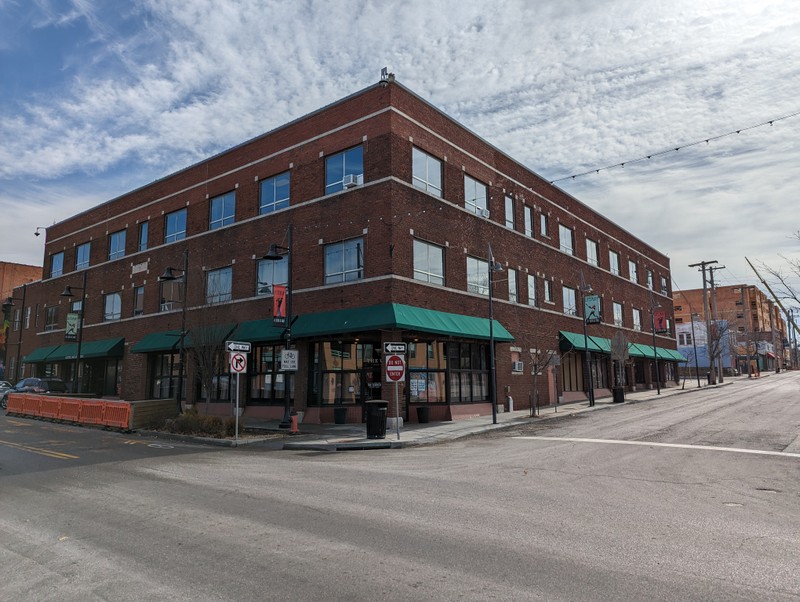Lincoln Building
Introduction
Author-Uploaded Audio
Introduction to the Lincoln Building by Michael Patton; recording created by Black Archives of Mid-America
Text-to-speech Audio
Constructed in 1921, this building was home to numerous African American professionals as well as retail and entertainment spaces throughout the 20th century. The building's name is a reference to the Lincoln Furniture Company which originally occupied much of the first floor along with the Lincoln Dance Hall which was located on the third floor and hosted many of the nation's leading jazz bands. In the decades that followed, the building housed the offices of the Kansas City Monarchs along with other Black-owned businesses which included many dentists, attorneys, and other professionals. Following an extensive renovation project that began in the late 1970s, the building has served as home to several community and civil rights organizations as well as restaurant and retail space.
Images
Picture of the Lincoln Building, dated 1940s.

Picture of the Lincoln Building, taken February 2nd, 2023

Picture of the interior courtyard of the Lincoln Building, added during remodeling in the 1980s. Picture taken February 2nd, 2023.

Backstory and Context
Text-to-speech Audio
The 18th & Vine Historic District is best known today as the place where the Kansas City style of jazz and blues were born, but for those who lived near the neighborhood, this was the central business hub, with everything from hotels and restaurants to stores and the offices of physicians and attorneys. The 18th & Vine District began as a “city within a city.” Starting around 1879, the first major migration of ex-slaves to the north brought thousands of African Americans to Kansas City. In fact, while the bulk of the “Great Migration” led African Americans to New York, Chicago, Philadelphia, and so forth, Kansas City was considered a second-tier industrial city. Around 1900, African Americans comprised about 10 percent of the city’s population. Many of the new arrivals made their homes and businesses along the district cross streets and, at the beginning of the 20th century, the neighborhood around 18th & Vine had become a thriving African American area. With segregation rampant throughout the city, African Americans found they could find all their day-to-day necessities in the area. There were schools, retail establishments, churches, and entertainment and social venues. Today, murals and monuments pay tribute to the Kansas City Monarchs and legendary musicians such as Charlie Parker and Count Basie, but in the 1920s, the area a shopping destination and business district above all else. The Lincoln Building was the center of commerce and home to numerous independent Black-owned businesses and offices for professionals.
As jazz music took hold in Kansas City around the 1920s, the Pendergast political machine in Kansas City purposefully overlooked violations of Prohibition. As a result, 18th & Vine was producing vibrant and lively dance halls and nightclubs. During the Great Depression, this area was at the height of its popularity and substantially contributed to the growth and evolution of Jazz music. Jazz legends who called 18th & Vine their home included Charlie Parker, Count Basie, George and Julia Lee, Big Joe Turner, John Coltrane, Mary Lou Williams, Bennie Moten, and many others. According to research by Heather Scanlon, the building opened in 1921, hosting the Lincoln Furniture Company and Matlaw's, a men's clothing store, on the ground floor. The second floor consisted of office space for professional use, while the third floor held Lincoln Hall, a music and dancing venue. In later years, the Lincoln Building remained an anchor for the district, housing numerous businesses and organizations. According to the African-American History Trail of Kansas City, during the 1940s, the building housed offices for the Kansas City Monarchs baseball team. Additionally, future Supreme Court Justice Thurgood Marshall operated out of the NAACP offices in the building during the 1951-1954 legal battle surrounding the desegregation of Swope Park Pool.
The building was remodeled by the Black Economic Union of Kansas City in 1981, and hosted numerous businesses throughout this time, including the Bayou on the Vine Cajun restaurant, which closed in 2016. In 2017, the building was purchased by Kansas City lawyer Henry C. Service. Currently, the Lincoln Building houses Service Law Offices, LLC, as well as offices for MKI Construction, 180V Barber Salon, the Kansas City, Missouri chapter of the NAACP, and the Corner Bar and Grill.
Sources
Coleman, Dan, Kansas City Public Library FAQs "Why did the area of 18th and Vine become famous?" The Kansas City Public Library, Accessed October 17, 2022.
Gibson, Campbell. "Population of the Largest 100 Cities and Other Urban Places in the United States: 1790 to 1990." U.S. Census Bureau. Population Division Working Paper No. 27, June 1998.
"Jazz District History." 18th & Vine Jazz District. 18th & Vine Jazz District Redevelopment Corporation, n.d. http://www.kcjazzdistrict.org/about/history Accessed October 17, 2022.
“Lincoln Building.” African American Heritage Trail of Kansas City. Accessed February 3, 2023. https://aahtkc.org/lincolnbuilding.
Scanlon, Heather. “The Lincoln Building.” SqueezeBoxCity, June 16, 2017. https://web.archive.org/web/20201205153820/http://www.squeezeboxcity.com/the-lincoln-building/.
Image courtesy of the Black Archives of Mid-America
Taken by Peter Sears, Black Archives of Mid-America Archives and Digitization VISTA
Taken by Peter Sears, Black Archives of Mid-America Archives and Digitization VISTA
